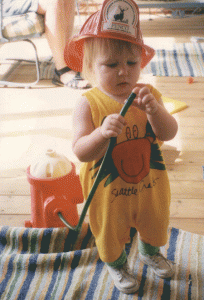 One of the presentations that I shared at the Laptop Institute was entitled Drinking from the Fire Hose:Rethinking Search and Research in a Digital Age. This was a two-year old presentation that I dusted off and updated significantly.
One of the presentations that I shared at the Laptop Institute was entitled Drinking from the Fire Hose:Rethinking Search and Research in a Digital Age. This was a two-year old presentation that I dusted off and updated significantly.
I was concerned that this topic was going to be too simple, too elementary since it was about a topic that all of us and our students do on a daily basis. However, I do know that the scales have been tipped.
No longer are we living in an age where we go to information oases (the library) . Instead, we are dropped into the deep end of the ocean and are asked to swim.
also
When asked to find out something, searchers, both children and adults will go to a single source, mostly Google, do one query, and accept the first four or five results as the best.
In order to examine this question, I needed to build the background and demonstrate why this was relevant to all all as digital learners. To do so, I first showed a very old (Internet timeline) video produced in late 2004, the EPIC 2014. This old Flash animation is eerily prophetic in light of the growth of the Internet. While they did not anticipate the growth of YouTube, I feel that they did accurately predict the conceptual emergence of Facebook.
Next, I fast-forwarded and juxtaposed the ideas from EPIC 2014 by showing the first 3 minutes of the 2011 TED Talk given by Eli Pariser, “Beware of Internet Filter Bubbles”
When seen right after EPIC 2014, it can be seen that this prediction has become a reality. Search results are being delivered based upon who you are, where you are, and what type of device you are using. I know that I experience this daily, when switching back and forth between my mobile devices and computer.
I then asked audience members three essential questions that need to help guide our work with all those who ask questions and seek answers, both adults and children:
- When you go to seek information, where do you go?
- When you find information, how did you establish its relevance and authority?
- When you find information, how did you determine its bias?
After a short time discussing these questions both in small groups and with the whole group, I then posed my big essential question that I hoped that they would take away and use to start conversations in their learning communities:
It used to be when you sent students to the Internet to find (gather) information, you did so wanting and expecting them to arrive in the vicinity of a source that you hoped they would find. You structured your instruction in hopes that there would be a greater likelihood that they would arrive where you had hoped.
However, in an environment where results are individualized and tailored to the individual, how do we need to change our curricular design and instruction to better guarantee that our students find what we hoped that they would find? Find something that will be relevant to their learning journey?
During the rest of the session, I shared both Google’s Advanced Search features and Custom Search, two tools which can be used to provide the framework and scaffolding to shape and guide new learner’s journeys into search. These tools, along with online, edited databases can better help a student curate the information in order to help them construct their knowledge.
I believe I was successful, planting seeds to initiate conversations around these topics.